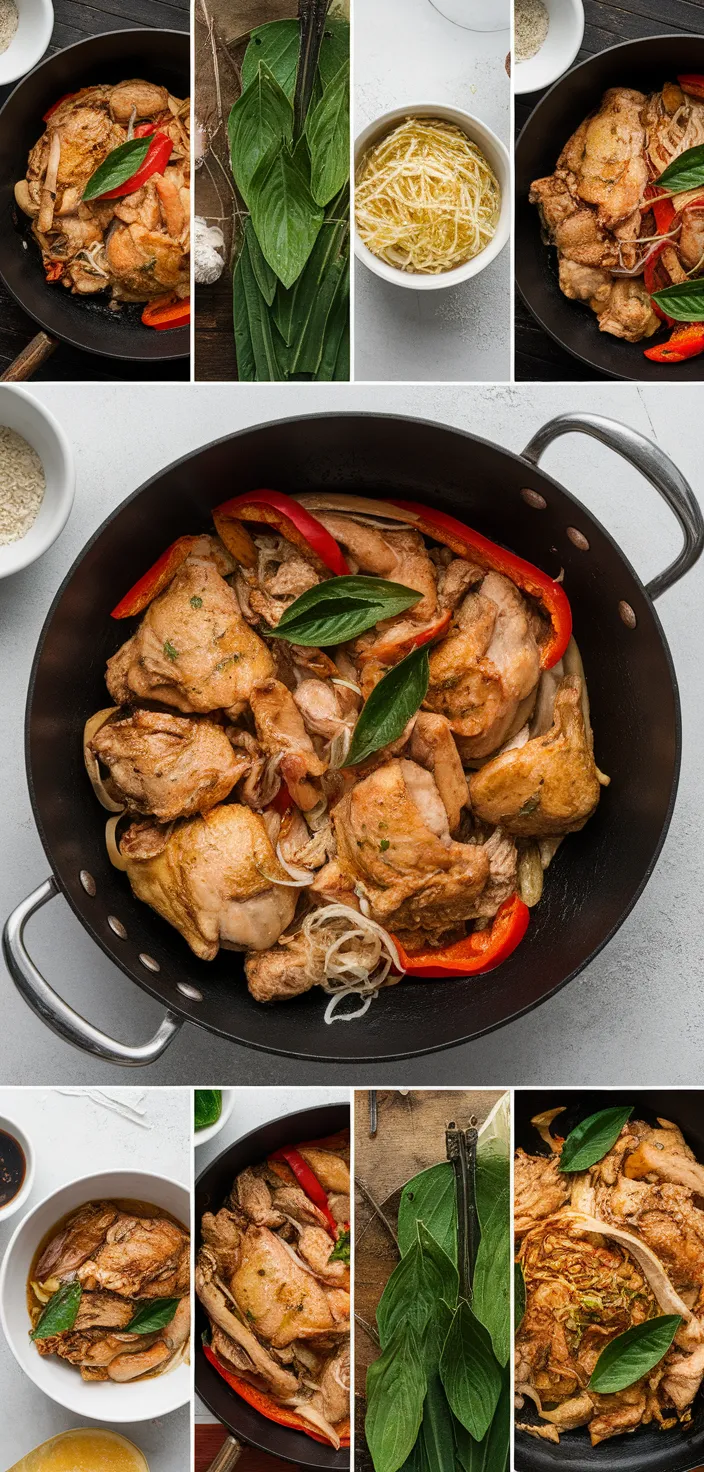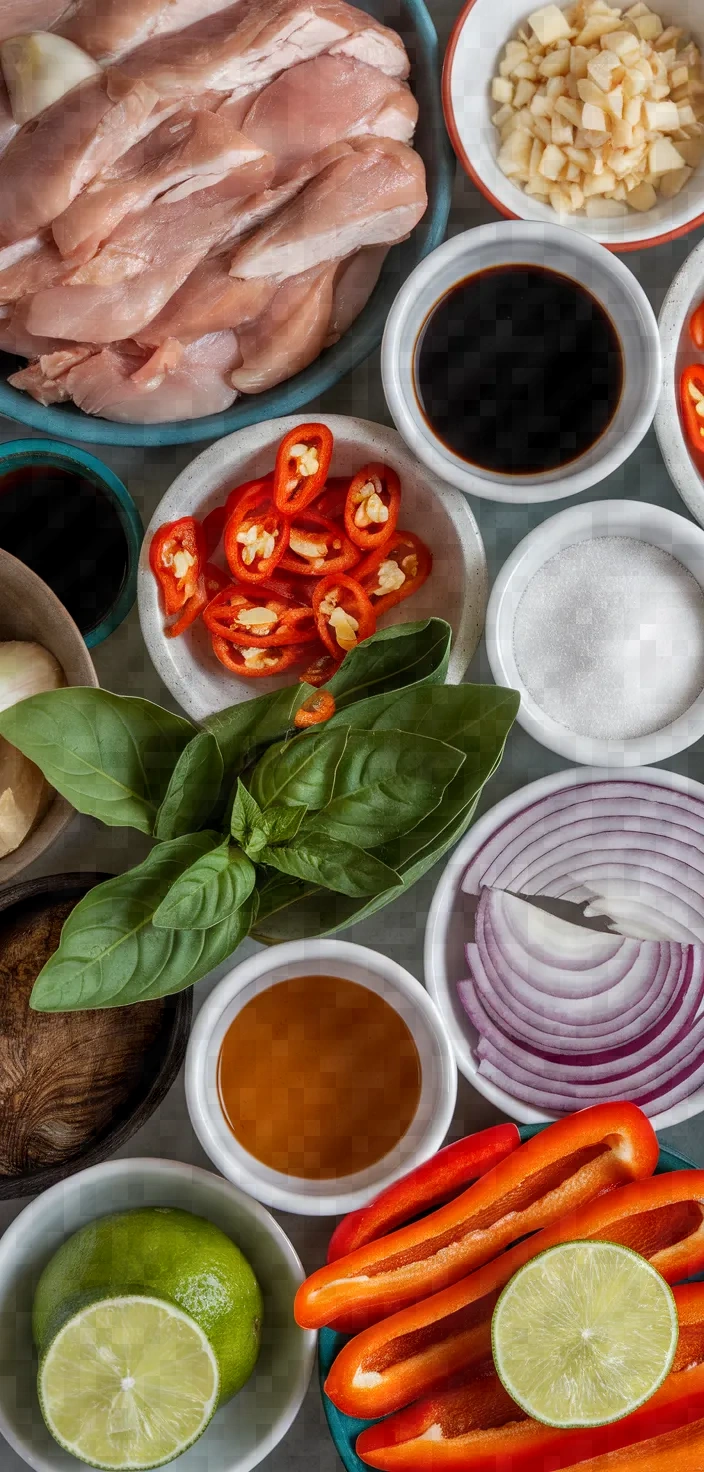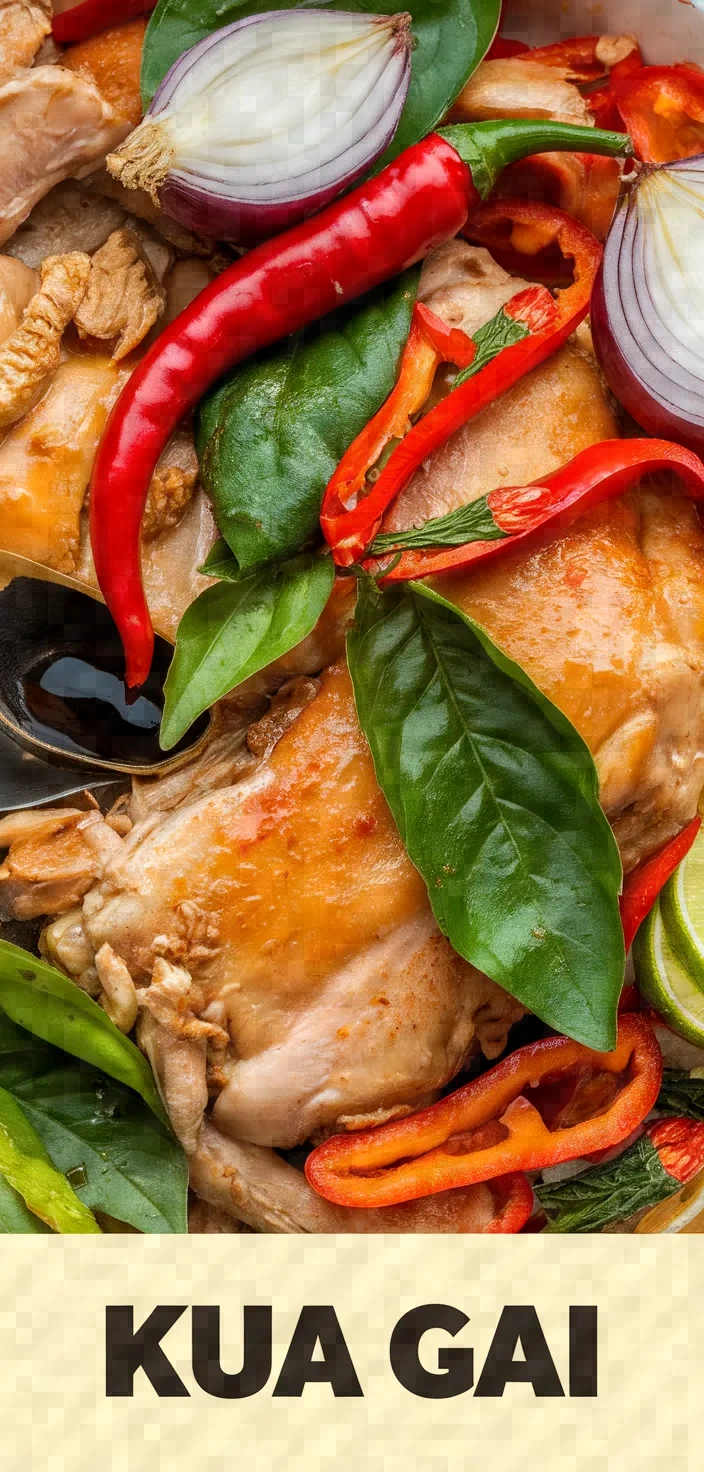This recipe for stir-fried chicken with holy basil is my absolute go-to because it combines bold, aromatic flavors with a quick cooking process, making it an ideal dish for busy weeknights. The irresistible combination of garlic, chilies, and Thai sauces creates a tantalizing dish that never fails to transport my taste buds straight to the bustling street markets of Thailand!

I have a strong passion for making real Thai meals, and Kua Gai is right up there among my favorites. It has thin, tender slices of boneless chicken thighs that are heated up with the vibrant spiciness of Thai bird chilies and the delightful aroma of minced garlic.
Those are the basics of this dish, but it gets even better when you add soy sauce, fish sauce, and oyster sauce, which combine to amp up the already rich flavor profile.
Ingredients

Consider chicken thighs for your next meal: they are high in protein, extremely juicy, and full of flavor, associating them with a rich umami quality that is hard to find in other parts of the chicken.
Garlic: Imparts a sharp smell and has antioxidant and anti-inflammatory properties.
Thai bird chilies.
Give a lot of heat and spiciness, and that boosts metabolism and flavor.
Soy sauce: Tasty and full of umami, it boosts the dish’s savory depth.
Sauce de poisson : fermentée, chargée d’umami, elle ajoute complexité et salinité.
The sauce made from oysters is sweet and savory, and it thickens and enriches the flavor of the dish.
Leaves of holy basil: A fragrant herb with a delightful burst of flavor, offering a fresh blast of a pepper-like taste.
Red bell pepper: Crunchy and sweet, and packed with antioxidants and vitamin C.
Juice from fresh limes: Bright and zesty, it blends flavors together and gives a desirable citrusy finish.
Ingredient Quantities
- 300g boneless chicken thighs, thinly sliced
- 2 tablespoons vegetable oil
- 3 cloves garlic, minced
- 4 Thai bird chilies, sliced
- 1 tablespoon soy sauce
- 1 tablespoon fish sauce
- 1 tablespoon oyster sauce
- 1 teaspoon sugar
- 2 tablespoons chicken stock or water
- 1 cup holy basil leaves
- 1 small onion, sliced
- 1 red bell pepper, sliced
- 1 tablespoon fresh lime juice
Instructions
1. In a wok or large frying pan, heat the vegetable oil over medium-high heat.
2. Stir-fry the minced garlic and sliced Thai bird chilies in the hot oil about 30 seconds, until they are fragrant.
3. Raise the heat to high, then add the chicken thighs, which have been cut into thin slices. Stir-fry until the chicken is done and is no longer pink, about 5-7 minutes.
4. Mix in the sliced onion and red bell pepper, making sure to cook them until they begin to soften, which should take about 2-3 minutes.
5. Add the soy sauce, fish sauce, oyster sauce, and sugar, and mix well to coat the chicken and vegetables evenly.
6. Stir in the chicken stock or water and let the amalgam simmer for about 2 minutes.
7. Add the holy basil leaves, and sauté just until they are limp and wafting their aroma.
8. Take the pan off the heat and mix in the fresh lime juice.
9. If needed, taste and adjust the seasoning. Add more soy sauce, fish sauce, or sugar as desired to balance the flavors.
10. Serve hot next to steamed rice or your selection of side dishes, and if you wish, garnish with a few more basil leaves.
Equipment Needed
1. Wok or large frying pan
2. Spatula or wooden spoon
3. Knife
4. Cutting board
5. Measuring spoons
6. Mixing bowls
FAQ
- Q: Can I use a different cut of chicken?A: Yes, if you prefer, you can use chicken breast, but chicken thighs tend to be juicier and more flavorful.
- Q: What can I substitute for Thai bird chilies?A: If you desire a lower level of heat, use a milder chili, such as a jalapeño, or leave it out completely.
- Q: Is there a vegetarian version of this recipe?A: Yes, for a vegetarian version, you can use tofu in place of the chicken and soy sauce instead of fish sauce.
- Q: Can I use regular basil instead of holy basil?A: Regular basil can be used in a pinch, but holy basil has a unique flavor.
- Q: How can I make it gluten-free?When choosing soy sauce, make sure to select the gluten-free type. Similarly, confirm that your oyster sauce and fish sauce are both gluten-free.
- Q: What can I serve with Kua Gai?Steamed jasmine rice or noodles are good companions for this dish.
Substitutions and Variations
Skinless chicken thighs without bones: Can be replaced with skinless chicken breast or softened firm tofu.
Use serrano peppers or adjust quantity with milder jalapeños to reduce spiciness when using Thai bird chilies.
Soy sauce or tamari can be used as an alternative to fish sauce; however, they will impart a slightly different flavor. Either can be used to achieve a more vegetarian-friendly dish, but they are not equal substitutes for the original ingredient.
Basil leaves: If you can’t find holy basil, use Thai basil or sweet basil. If you can’t find either of those, use spinach.
Vegetable broth or water makes a great substitute for chicken stock when you want a lighter dish. If you use broth, make sure it’s a light vegetable broth.
Pro Tips
1. Marinate the Chicken For extra flavor, marinate the chicken slices in a mixture of soy sauce, fish sauce, and a pinch of sugar for about 15-20 minutes before cooking. This allows the chicken to absorb the sauces and enhances the overall taste of the dish.
2. Control the Heat Be attentive to the heat level during cooking. Stir-frying is best done over high heat to quickly cook the ingredients while retaining their texture. However, if your pan isn’t hot enough, the chicken and vegetables might not sear properly, leading to a soggy texture.
3. Use Fresh Ingredients For the best flavor, use fresh holy basil leaves and fresh Thai bird chilies. If you can’t find holy basil, you can substitute it with Thai basil or sweet basil, but it will alter the flavor slightly.
4. Balance the Flavors Before serving, taste the dish and adjust the seasonings. If it’s too spicy, a little sugar can moderate the heat. If the flavors aren’t popping, a squeeze more lime juice can enhance the dish’s brightness and balance.
5. Prepare Ingredients in Advance Since stir-frying is a fast process, have all your ingredients prepped and ready to go before you start cooking. This includes slicing the chicken, onions, and bell peppers, and having all sauces measured out.

Kua Gai Recipe
My favorite Kua Gai Recipe
Equipment Needed:
1. Wok or large frying pan
2. Spatula or wooden spoon
3. Knife
4. Cutting board
5. Measuring spoons
6. Mixing bowls
Ingredients:
- 300g boneless chicken thighs, thinly sliced
- 2 tablespoons vegetable oil
- 3 cloves garlic, minced
- 4 Thai bird chilies, sliced
- 1 tablespoon soy sauce
- 1 tablespoon fish sauce
- 1 tablespoon oyster sauce
- 1 teaspoon sugar
- 2 tablespoons chicken stock or water
- 1 cup holy basil leaves
- 1 small onion, sliced
- 1 red bell pepper, sliced
- 1 tablespoon fresh lime juice
Instructions:
1. In a wok or large frying pan, heat the vegetable oil over medium-high heat.
2. Stir-fry the minced garlic and sliced Thai bird chilies in the hot oil about 30 seconds, until they are fragrant.
3. Raise the heat to high, then add the chicken thighs, which have been cut into thin slices. Stir-fry until the chicken is done and is no longer pink, about 5-7 minutes.
4. Mix in the sliced onion and red bell pepper, making sure to cook them until they begin to soften, which should take about 2-3 minutes.
5. Add the soy sauce, fish sauce, oyster sauce, and sugar, and mix well to coat the chicken and vegetables evenly.
6. Stir in the chicken stock or water and let the amalgam simmer for about 2 minutes.
7. Add the holy basil leaves, and sauté just until they are limp and wafting their aroma.
8. Take the pan off the heat and mix in the fresh lime juice.
9. If needed, taste and adjust the seasoning. Add more soy sauce, fish sauce, or sugar as desired to balance the flavors.
10. Serve hot next to steamed rice or your selection of side dishes, and if you wish, garnish with a few more basil leaves.
